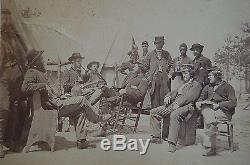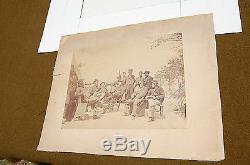CIVIL WAR 1860s Matthew Brady LARGE Mammoth Plate Photo GROUP OF OFFICERS Slave






This listing is for an original large albumen cabinet photo hand titled "Group of Officers". It shows a group of white civil war officers next to their tent being waited on by a black servant. Another black servant peeks out of his tent. There is also a young lady visiting. Nice clear photo with great contrast. No photographer noted, but I suspect it is a Matthew Brady based on its size and quality. I took pics both inside in bad light and outside in extreme sunlight. Card measures about 14" X 18". Albumen photo on the card measures 9-3/4" X 12-3/4". I took several photos of this item please scroll down to see them all. Pics give an accurate portrayal of condition. Please look at the photos to get an idea of what this is. I may not be able to answer your questions immediately, but every question will be answered. Realistic reserve set just to protect my investment, if there is a reserve at all. Good luck and thanks for looking!! Over 100,000,000 served. Get FREE counters from Vendio today! More than just a pretty picture. Brady (May 18, 1822 § January 15, 1896) was one of the first American photographers, best known for his scenes of the Civil War.
He studied under inventor Samuel F. Morse, who pioneered the daguerreotype technique in America.
Brady opened his own studio in New York in 1844, and photographed Andrew Jackson and John Quincy Adams, among other celebrities. When the Civil War started, his use of a mobile studio and darkroom enabled vivid battlefield photographs that brought home the reality of war to the public. Thousands of war scenes were captured, as well as portraits of generals and politicians on both sides of the conflict, though most of these were taken by his assistants, rather than by Brady himself. Brady's fortunes declined sharply, and he died in debt. Brady was born on May 18, 1822 in Warren County, New York near Lake George, the youngest of three children of Irish immigrant parents, Andrew and Samantha Julia Brady. [1] At age 16 he moved to Saratoga, New York, where he met famed portrait painter William Page.Brady became Page's student. In 1839 the two traveled toAlbany, New York, and then to New York City, where Brady continued to study painting with Page, and also with Page's former teacher, Samuel F. At first, his involvement was limited to manufacturing leather cases that held daguerrotypes.
[3] But soon he became the center of the New York artistic colony that wished to study photography. He opened a studio and offered classes; Brady was one of the first students.
[4] In 1844 Brady opened his own photography studio in New York, [5] and by 1845 he began to exhibit his portraits of famous Americans. He opened a studio inWashington, D. In 1849, where he met Juliet (whom everybody called'Julia') Handy, whom he married in 1851 and lived with on Staten Island. [6] [7] Brady's early images were daguerreotypes, and he won many awards for his work; in the 1850s ambrotype photography became popular, which gave way to the albumen print, a paper photograph produced from large glass negatives most commonly used in the American Civil War photography. In 1850 Brady produced The Gallery of Illustrious Americans, a portrait collection of prominent contemporary figures.
The album, which featured noteworthy images including the elderly Andrew Jackson at the Hermitage, was not financially rewarding but invited increased attention to Brady's work and artistry. In 1856 Brady placed an ad in the New York Herald paper offering to produce photographs, ambrotypes and daguerreotypes. [8] This inventive ad pioneered, in the USA, the use of typeface and fonts that were distinct from the text of the publication and from that of other advertisements.
At first, the effect of the Civil War on Brady's business was a brisk increase in sales of cartes de visite to transient soldiers. In fact, Brady readily marketed to parents the idea of capturing their young soldiers' images before they might be lost to war by running an ad in The New York Daily Tribune that warned, You cannot tell how soon it may be too late.
[3] However, he was soon taken with the idea of documenting the war itself. He first applied for permission to travel to the battle sites to an old friend, General Winfield Scott, and eventually he made his application to President Lincoln himself. Lincoln granted permission in 1861 with the proviso that Brady finance the project himself. [1] His efforts to document the American Civil War on a grand scale by bringing his photographic studio right onto the battlefields earned Brady his place in history. Despite the obvious dangers, financial risk, and discouragement of his friends, Brady is later quoted as saying I had to go. A spirit in my feet said'Go,' and I went. His first popular photographs of the conflict were at the First Battle of Bull Run, in which he got so close to the action that he barely avoided capture. He employed Alexander Gardner, [10] James Gardner, Timothy H. O'Sullivan, William Pywell, George N. Roche, and seventeen other men, each of whom was given a traveling darkroom, to go out and photograph scenes from the Civil War. Brady generally stayed in Washington, D. Organizing his assistants and rarely visited battlefields personally. This may have been due, at least in part, to the fact that Brady's eyesight had begun to deteriorate in the 1850s. In October 1862 Brady opened an exhibition of photographs from the Battle of Antietam in his New York gallery titled The Dead of Antietam. Many images in this presentation were graphic photographs of corpses, a presentation new to America. This was the first time that many Americans saw the realities of war in photographs as distinct from previous "artists' impressions". Mathew Brady, through his many paid assistants, took thousands of photos of American Civil War scenes.Much of the popular understanding of the Civil War comes from these photos. There are thousands of photos in the National Archives and the Library of Congress taken by Brady and his associates, Alexander Gardner, George Barnard, and Timothy O'Sullivan. [10] The photographs include Lincoln, Grant, and common soldiers in camps and battlefields. The images provide a pictorial cross reference of American Civil War history. Brady was not able to photograph actual battle scenes as the photographic equipment in those days was still in the infancy of its development and required that a subject be still in order for a clear photo to be produced.
[11] Following the conflict, a war-weary public lost interest in seeing photos of the war, and Brady's popularity and practice declined drastically. Depressed by his financial situation, loss of eyesight and devastated by the death of his wife in 1887, he became very lonely. He died penniless in the charity ward ofPresbyterian Hospital in New York City on January 15, 1896, from complications following a streetcar accident. Brady's funeral was financed by veterans of the 7th New York Infantry. He was buried in the Congressional Cemetery in Washington, D.
Levin Corbin Handy, Brady's nephew by marriage, took over Brady's photography business after his death. Legacy and people photographed[edit] Brady photographed 18 of the 19 American Presidents from John Quincy Adams to William McKinley. The exception was the 9th President, William Henry Harrison, who died in office three years before Brady started his Photographic Collection.
The thousands of photographs which Mathew Brady's photographers (such as Alexander Gardner and Timothy O'Sullivan) took have become the most important visual documentation of the Civil War, and have helped historians and the public better understand the era. Brady photographed and made portraits of many senior Union officers in the war, including Ulysses S. Grant, Nathaniel Banks, Don Carlos Buell, Ambrose Burnside, Benjamin Butler, Joshua Chamberlain, George Custer, David Farragut, John Gibbon, Winfield Hancock, Samuel P. Heintzelman, Joseph Hooker, Oliver Howard, David Hunter, John A. Logan, Irvin McDowell, George McClellan, James McPherson, George Meade, Montgomery C. Meigs, David Dixon Porter, William Rosecrans, John Schofield, William Sherman, Daniel Sickles, Henry Warner Slocum, George Stoneman, Edwin V. Sumner, George Thomas, Emory Upton, James Wadsworth, and Lew Wallace. On the Confederate side, Brady photographed Jefferson Davis, P. Beauregard, Stonewall Jackson, James Longstreet, Lord Lyons, James Henry Hammond, and Robert E. LeeLee's first session with Brady was in 1845 as a lieutenant colonel in the U. Army, his final after the war in Richmond, Virginia. Brady photographed Abraham Lincoln on many occasions.[12] Brady is credited with being the father of photojournalism. [13] He can also be considered a pioneer in the orchestration of a corporate credit line. " In this practice, every image produced in his gallery was labeled "Photo by Brady; however, Brady dealt directly with only the most distinguished subjects and most portrait sessions were carried out by others.
[14] As perhaps the best-known US photographer in the 19th century, it was Brady's name that came to be attached to the era's heavy specialized end tables which were factory-made specifically for use by portrait photographers. Such a "Brady stand" of the mid-19th century typically had a weighty cast iron base for stability, plus an adjustable-height single-column pipe leg for dual use as either a portrait model's armrest or (when fully extended and fitted with a brace attachment rather than the usual tabletop) as a neck rest. The latter was often needed to keep models steady during the longer exposure times of early photography. While Brady stand is a convenient term for these trade-specific articles of studio equipment, there is no proven connection between Brady himself and the Brady stand's invention circa 1855.
[15] Brady and his Studio produced over 7,000 pictures (mostly two negatives of each). One set "after undergoing extraordinary vicissitudes, " came into U.
His own negatives passed in the 1870s to E. They "were kicked about from pillar to post" for 10 years, until John C. Taylor found them in an attic and bought them; from this they became the backbone of the Ordway§Rand collection; and in 1895 Brady himself had no idea of what had become of them. Many were broken, lost, or destroyed by fire.After passing to various other owners, they were discovered and appreciated by Edward Bailey Eaton, " who set in motion "events that led to their importance as the nucleus of a collection of Civil War photos published in 1912 as The Photographic History of the Civil War. [16] Some of the lost images are mentioned in the last episode of Ken Burns' 1990 documentary on the Civil War.
In the years that followed the end of the war, the sun slowly burned away their filmy images and they were lost. [17] Following considerable controversy around the racist history of city founder W. Tate Brady, for whom a major street and neighborhood was named, the City Council of Tulsa, OK on August 15, 2013, voted to retain the name Brady Street, but that it would now honor Mathew B.Photography exhibition: "The Dead of Antietam" at Brady's New York gallery October 1862[edit] On September 19, 1862, two days after the Battle of Antietam, the bloodiest day of combat on U. Soil with more than 23,000 killed, wounded or missing, Mathew Brady sent photographer Alexander Gardner and his assistant James Gibson to photograph the carnage. In October 1862 Brady displayed the photos by Gardner at Brady's New York gallery. [18] The New York Times published a review. [19] In October 2012, theNational Museum of Civil War Medicine displayed 21 original Mathew Brady 1862 photographs documenting the Civil War's Battle of Antietam.
The item "CIVIL WAR 1860s Matthew Brady LARGE Mammoth Plate Photo GROUP OF OFFICERS Slave" is in sale since Monday, August 03, 2015. This item is in the category "Collectibles\Militaria\Civil War (1861-65)\Original Period Items\Photographs". The seller is "bm75" and is located in Westminster, California. This item can be shipped worldwide.

